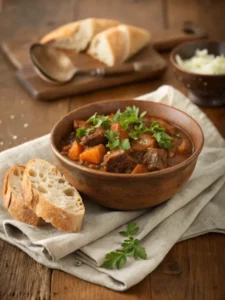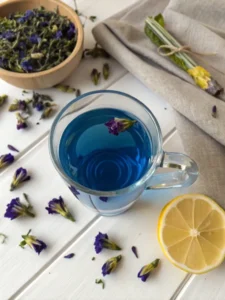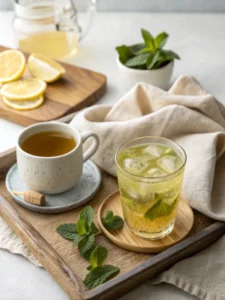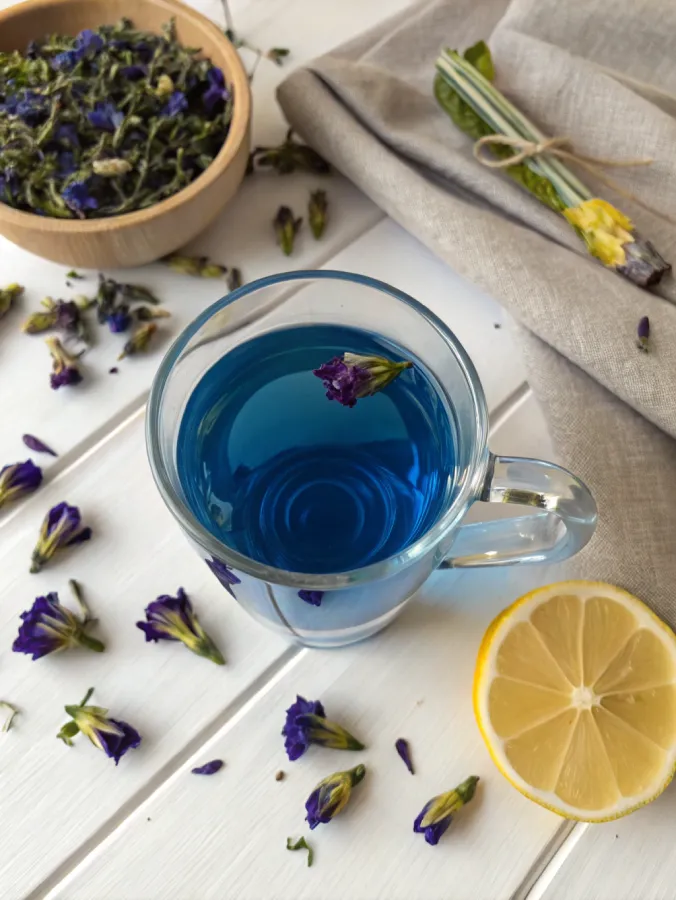
Hi, I’m Deen – welcome! One rainy day in Asheville, I discovered butterfly pea flower tea in the back of my tea drawer. Its electric blue color and calming effects instantly won me over. What started as a curiosity became part of my weekly ritual. I love how this caffeine-free tea soothes my nerves, supports brain clarity, and adds a touch of magic to my cup. Whether you sip it hot or cold, it’s a beautiful way to slow down and nourish your day, no fancy tools required, just warm water and a little wonder.
In this Article
Key Takeaways: What You Need To Know
Butterfly pea flower tea is a vibrant, naturally caffeine-free herbal drink made from the dried petals of the Clitoria ternatea plant. Known for its rich blue color and ability to change hues with lemon, it’s packed with antioxidants and linked to benefits for skin, hair, brain health, and relaxation. It can be enjoyed hot or iced, and it’s a beautiful, calming addition to any tea routine.
A Colorful Discovery – Why I Fell in Love with Butterfly Pea Flower Tea
A Happy Discovery in the Tea Drawer
I stumbled across butterfly pea flower tea on a rainy afternoon in Asheville, rummaging through a forgotten basket of herbal blends. The package didn’t look like much, but the name caught my eye. Butterfly pea flower tea? I was curious. The first steep turned the water a deep ocean blue. Add a squeeze of lemon? It morphed into a rich violet-purple, almost like a magic trick.
As someone who once relied on strong coffee and stress to push through the day, I’ve come to treasure rituals that slow me down. Brewing this vibrant, caffeine-free tea felt like a quiet rebellion against chaos. Since that first cup, it’s become part of my weekly rhythm, especially in the evenings when I crave something soothing that won’t keep me up.
What I didn’t expect was how good it made me feel, not just relaxed, but clearer-headed. I’d later learn that butterfly pea flower tea supports brain health, calms the nervous system, and may even help with focus and memory. Now, it sits beside my favorite blends like honey lemon ginger tea and apple cider vinegar lemon and honey, both warm and grounding, but this one adds a little color magic to the mix.
Butterfly pea flower tea isn’t just about looks. It’s a gentle, nourishing herbal brew with deep roots in Southeast Asian tradition, where it’s long been used for vitality and beauty. And today, it’s gaining recognition across the globe as more people seek natural, plant-based ways to relax and recharge.
Butterfly Pea Flower Tea Benefits for Body & Mind
Skin, Hair, and Brain Boosting Perks
Butterfly pea flower tea isn’t just visually stunning, it’s packed with antioxidants and flavonoids that support your body from the inside out. These natural compounds help protect your cells from oxidative stress, which is linked to aging, inflammation, and dull skin. Drinking a cup regularly may help you maintain a clearer, brighter complexion.
But its beauty benefits don’t stop there. Traditional use of Clitoria ternatea, the plant behind butterfly pea flower tea, includes support for hair health. Rich in anthocyanins, it promotes stronger follicles, potentially reducing hair fall and premature greying. It’s even included in natural hair rinses and masks across Southeast Asia.
Perhaps most impressive, though, is how this tea supports brain function. Butterfly pea flower tea contains nootropics, plant compounds that may boost memory, learning, and mental clarity. Some studies suggest it increases acetylcholine levels in the brain, a neurotransmitter essential for cognitive performance. This is why it’s often used in Ayurvedic remedies to improve focus, especially in older adults.
For a full-body wellness approach, I love pairing this tea with green tea during the day or sipping it alongside something comforting like ron ron juice when winding down. Both support hydration and recovery while adding variety to my herbal lineup.
Naturally Detoxifying and Caffeine-Free
One of the most appealing things about butterfly pea flower tea is that it’s completely caffeine-free. That means you can enjoy it any time of day without worrying about jitters or sleep disruption.
It also acts as a gentle detoxifier. Thanks to its antioxidant load, it helps flush out free radicals and may support liver function over time. That makes it a lovely alternative to sugary drinks or heavily processed detox teas, especially when paired with whole-food, nutrient-rich recipes like those found in the Mediterranean diet.
If you’re looking for a daily drink that tastes good, looks beautiful, and supports both mood and metabolism, butterfly pea flower tea fits the bill.
What Butterfly Pea Tea Tastes Like and How to Enjoy It
Floral, Earthy, and Slightly Sweet
Butterfly pea flower tea has a gentle, earthy flavor with mild floral notes. It’s not bold like black tea or sharp like hibiscus, instead, it’s subtle, almost meditative. Many describe the initial taste as similar to lightly steamed rice or green beans, followed by a soft finish that’s slightly sweet, like dry bread crust or chamomile.
Its soothing taste makes it a perfect base for creative blends. If you’re used to stronger herbal teas like honey lemon ginger, this one might feel light at first. But don’t let that fool you, it holds its own with calming, almost grounding undertones. The aroma is equally gentle, with hints of warm earth and meadow flowers.
You can also enhance the flavor with a drizzle of honey, a splash of citrus, or even a few fresh mint leaves. This flexibility makes butterfly pea flower tea ideal for both beginners and tea lovers looking to expand their herbal collection.
Tips to Serve It Hot, Iced, or With Lemon
One of the most enchanting things about butterfly pea flower tea is its color-changing magic. Brewed alone, the tea is a deep blue. Add lemon or any acidic ingredient, and it shifts to a vibrant purple. This makes it a fun conversation starter at gatherings, or simply a beautiful way to treat yourself during a quiet moment.
For a hot cup, steep dried flowers in just-boiled water for 5–7 minutes. For iced tea, chill the brew and pour it over ice with lemon slices or berries. Want to go next level? Pair it with recipes like the adrenal cocktail to support hydration and recovery post-workout.
It’s also a popular base for mocktails, cocktails, and wellness tonics thanks to its striking hue and gentle taste. You can even use it in desserts, smoothies, or to tint rice and noodles naturally.
How to Make Butterfly Pea Flower Tea
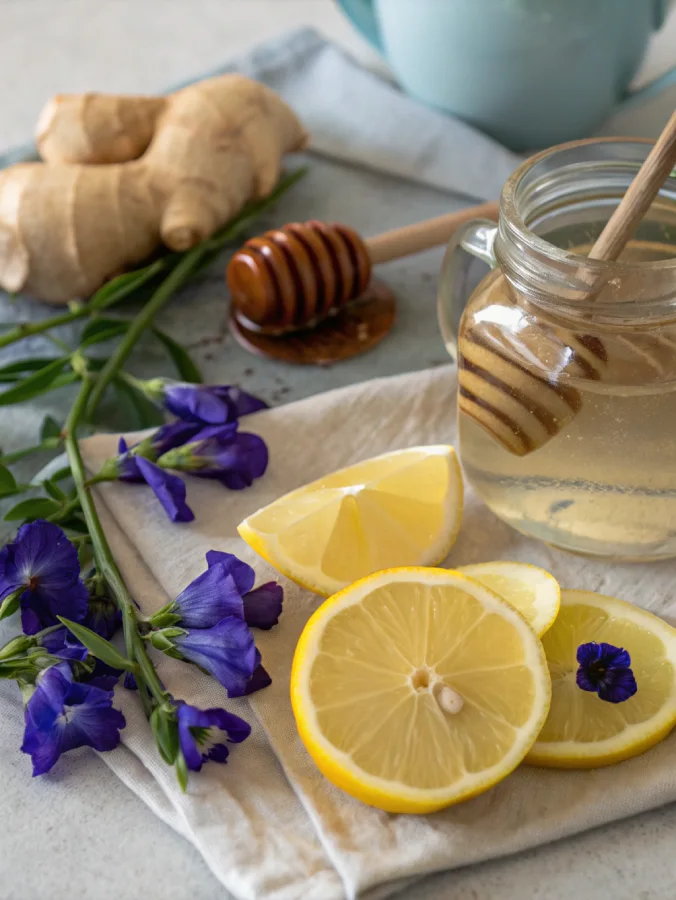
Ingredients & Equipment You’ll Need
Making butterfly pea flower tea at home is simple and rewarding. All you need are a few pantry staples and a quiet moment. The base recipe includes:
- 1 teaspoon of dried butterfly pea flowers (about 5–6 flowers)
- 1 cup (8 oz) of hot filtered water
- Optional: lemon juice, honey, ginger slices, or mint
If you’re just getting started, you can find organic dried butterfly pea flowers in resealable pouches at natural food stores or online. Choose a product that’s free of additives or preservatives, with a vibrant color and subtle floral aroma.
As for tools, you’ll need:
- A tea kettle or small saucepan to boil water
- A mug or heat-safe glass
- A tea infuser or fine mesh strainer
Butterfly pea tea also makes a beautiful base for custom blends. I love adding a few slices of fresh ginger for extra warmth, or pairing it with the herbal Costa Rican tea recipe on cooler days when I need a little comfort.
Step-by-Step Simple Brewing Guide
- Boil the water to around 200°F (just under a rolling boil).
- Add the dried flowers to your infuser or teapot.
- Pour the hot water over the flowers, cover, and let steep for 5–7 minutes.
- Watch the color transform into a rich blue as it steeps.
- Optional: Add a squeeze of lemon to turn the tea purple, or a spoonful of honey to sweeten.
Serve it hot to unwind before bed, or chill it and enjoy over ice with a sprig of mint. I often drink it alongside lighter recipes like my pink salt trick to hydrate and replenish minerals.
This tea isn’t just easy to brew, it’s beautiful, functional, and incredibly relaxing.
Is It Safe? Side Effects, Dosage & Who Should Avoid It
Recommended Daily Intake and Safety Info
Butterfly pea flower tea is considered safe for most people and has a long history of use in Ayurvedic and traditional Southeast Asian medicine. Since it’s naturally caffeine-free and made from flowers, not stems or leaves, it’s gentle on the body and unlikely to cause digestive upset.
For general wellness, 1 to 2 cups a day is ideal. A standard dose uses 1 teaspoon of dried flowers per 8 ounces of water, brewed for 5–7 minutes. This amount delivers a light infusion of antioxidants, flavonoids, and brain-boosting compounds without overwhelming your system.
Drinking more than three cups a day won’t necessarily increase benefits and may, for some, cause mild nausea or stomach discomfort. Like with any herbal tea, moderation is key. If you’re new to it, start with a half-cup and observe how your body responds.
It’s also wise to avoid drinking it alongside prescription medications without consulting your doctor. Even though butterfly pea tea is natural, it may still interact with certain drugs, especially those affecting blood pressure or blood sugar.
For safe enjoyment, I love having a cup in the late afternoon, especially when I want something calming but non-drowsy. It pairs well with gelatin trick recipes for a nourishing snack that supports skin and joints.
Who Should Not Drink Butterfly Pea Tea
While generally safe, some people should proceed with caution:
- Pregnant or breastfeeding women should consult a healthcare provider first. There’s not enough conclusive research on its effects during pregnancy.
- People with low blood pressure or taking antihypertensive medication may experience lightheadedness.
- Those with diabetes or on insulin should monitor their blood sugar, as this tea may have mild glucose-lowering effects.
Always check with a healthcare professional if you’re managing a condition or taking medication. If unsure, consider switching to a milder herbal option like the tea used in Chinese restaurants as a backup.
Butterfly Pea Tea in Culture & Science
Traditional Use in Ayurveda and Southeast Asia
Butterfly pea flower tea has been used for centuries in Southeast Asian traditions and Ayurvedic medicine. In Thailand, it’s known as nam dok anchan, often served with honey and lemon as a welcome drink. In India, it’s valued for its role in balancing the three doshas, Vata, Pitta, and Kapha, and is believed to calm the mind, support memory, and promote youthfulness.
The butterfly pea flower, known scientifically as Clitoria ternatea, is more than just a pretty bloom. It’s used in religious rituals, beauty treatments, and even natural dyes. The vivid blue color of butterfly pea flower tea symbolizes clarity and peace in many spiritual practices.
In traditional medicine, butterfly pea flower tea has been praised as a “brain tonic,” especially when consumed daily. Its effects are believed to strengthen memory and focus, which is why Ayurvedic texts list it among the top herbs for mental clarity.
In modern kitchens, this herbal tea has become a creative tool, used in smoothies, cocktails, mocktails, and colorful dishes like rice and jelly desserts. At home, I like to add it to blends like my apple cider vinegar, lemon, and honey drink when I want a boost with visual flair.
Scientific Findings and Nutritional Composition
Modern research confirms what ancient wisdom suggested: butterfly pea flower tea is rich in anthocyanins, flavonoids, and antioxidants. These compounds help protect cells from oxidative damage, making this tea supportive of long-term brain, eye, and skin health.
Studies have shown that butterfly pea flower tea may improve memory, reduce inflammation, and offer neuroprotective benefits. It’s also being explored for its antidiabetic, antiasthmatic, and antimicrobial potential.
According to a study published by the NIH, extracts from Clitoria ternatea positively influence acetylcholine levels, which support memory and concentration, especially helpful for older adults.
Even the USDA includes butterfly pea flower under its recognized list of herbal supplements due to its bioactive profile (USDA Reference).
For curious minds, experimenting with butterfly pea flower tea alongside nutrient-packed recipes like the mediterranean diet food list is a tasty way to integrate ancient wisdom and modern science into daily life.
Where to Buy, Store, and Explore More Tea Recipes
Sourcing Organic Dried Butterfly Pea Flower Tea
Finding high-quality butterfly pea flower tea is easier than ever thanks to its rising popularity in wellness and herbal communities. When shopping online or in-store, look for 100% dried butterfly pea flowers with no fillers, preservatives, or added flavors. The flowers should be vibrant blue, with a fresh, lightly floral aroma, not musty or faded.
Make sure the product is food-grade and packaged in airtight, resealable bags. Certified organic butterfly pea flower tea is ideal if you’re aiming for the cleanest brew possible. Brands that specialize in herbal wellness blends, such as Teacurry or Blue Tea, often offer single-ingredient butterfly pea flower tea in teabags or loose-leaf form.
Once opened, store your butterfly pea flower tea in a cool, dry place away from light and moisture. A sealed glass jar or tin works great. Stored properly, the tea will retain its color and potency for up to 12 months.
I like keeping mine next to other staples like the apple cider vinegar lemon and honey tonic and honey lemon ginger tea, they all create beautiful, nourishing moments in my daily kitchen rhythm.
Deen’s Favorite Tea Recipes with a Twist
Butterfly pea flower tea is incredibly versatile. You can drink it on its own, or combine it with other herbs, fruits, and spices to create custom infusions. One of my favorites is mixing butterfly pea flower tea with ginger and lemon, watching the color shift from deep blue to purple is a joy every time.
For something even more restorative, try blending it with adrenal-supporting drinks like the adrenal cocktail, or pair it with vibrant teas from my Costa Rican tea recipe for a naturally energizing combo.
Whether you enjoy it hot, iced, or mixed into recipes, butterfly pea flower tea brings color, calm, and clean nutrition to every sip.

Butterfly Pea Flower Tea
Ingredients
Equipment
Method
- Boil 1 cup of water to about 200°F.
- Add dried butterfly pea flowers to an infuser or teapot.
- Pour hot water over the flowers and cover.
- Let steep for 5–7 minutes until the tea turns deep blue.
- Remove flowers and stir in lemon, honey, or ginger if desired.
- Serve hot or iced with optional mint garnish.
Nutrition
Notes
Tried this recipe?
Let us know how it was!FAQs About Butterfly Pea Flower Tea
What does butterfly pea flower tea good for?
Butterfly pea flower tea is good for improving brain function, reducing anxiety, promoting skin glow, supporting hair health, and aiding in digestion. It’s rich in antioxidants and anthocyanins, which help fight inflammation and oxidative stress in the body.
Who should not drink butterfly pea tea?
People who are pregnant, breastfeeding, taking blood pressure medication, or managing low blood sugar should avoid butterfly pea tea unless approved by a healthcare provider. While it’s generally safe, it may interact with certain medications or conditions.
Is it safe to drink butterfly pea tea every day?
Yes, it’s safe for most people to drink butterfly pea tea daily in moderation. One to two cups a day is ideal to enjoy the health benefits without overwhelming the system. It’s naturally caffeine-free, making it suitable even in the evening.
What does butterfly pea tea taste like?
Butterfly pea flower tea has a mild, earthy taste with floral undertones. Some describe it as similar to green beans or steamed rice, with a soft sweetness. Adding lemon or honey enhances both flavor and color, turning the blue tea into a rich purple.
Conclusion
Butterfly pea flower tea is more than just a visual delight, it’s a calming, antioxidant-rich herbal infusion that nourishes your skin, supports brain clarity, and brings a little magic to your cup. Whether you’re sipping it hot or iced, blending it into recipes, or simply enjoying the color-changing wonder, this tea fits beautifully into any routine.
As someone who found comfort and creativity in brewing butterfly pea flower tea, I can tell you, it’s one small ritual that transforms an ordinary day. So grab some dried flowers, steep a cup, and enjoy the calming color and taste that has captured tea lovers across the world.
